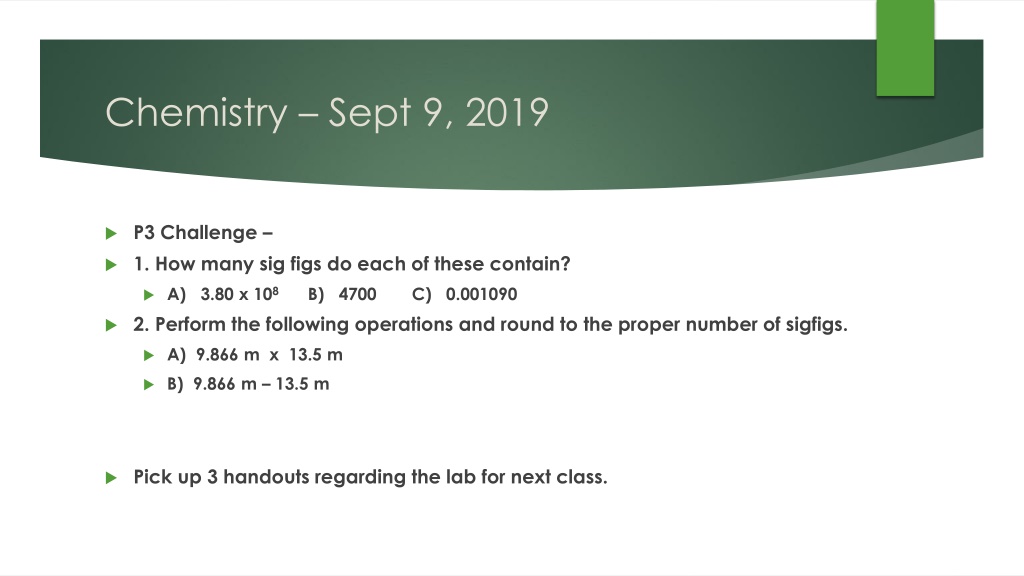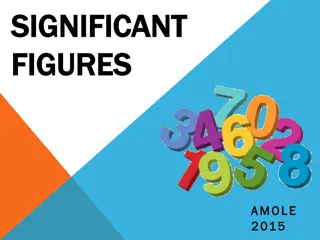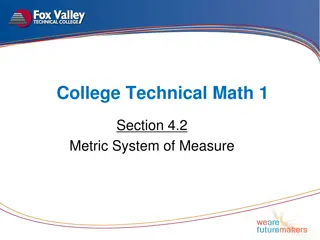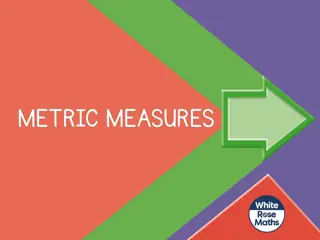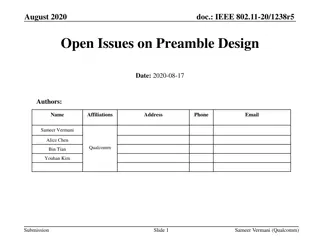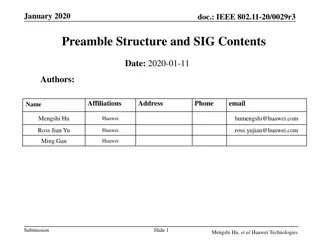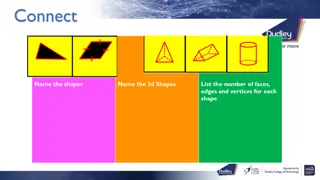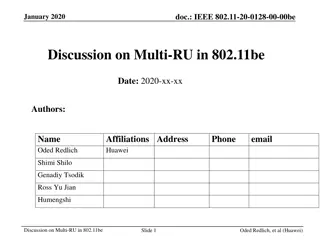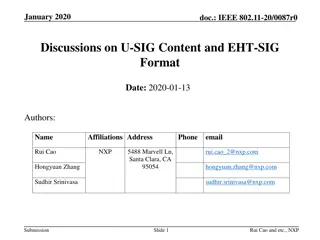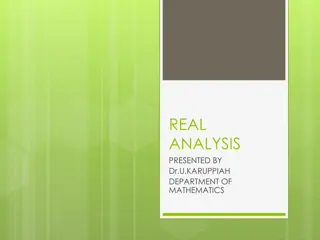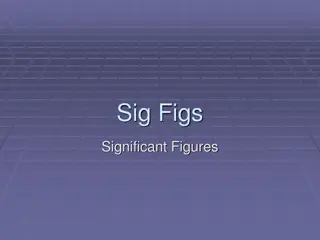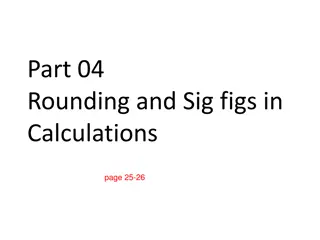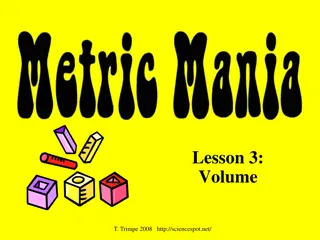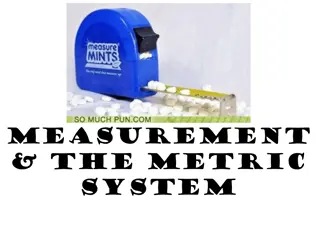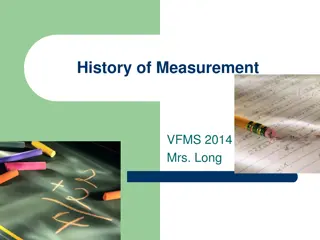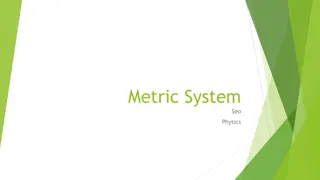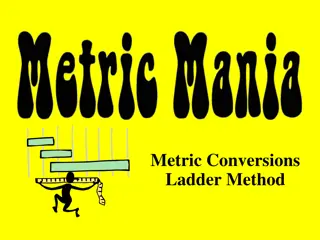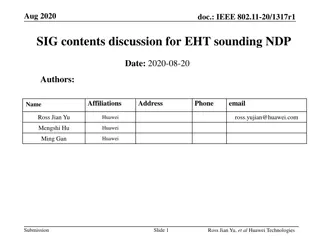Understanding Metric System and Sig Figs in Chemistry
Explore the fundamentals of the metric system, significant figures, and unit conversions in the context of chemistry. Gain insights into the mole concept, prefixes, and methods for handling calculations with appropriate precision. Get ready to tackle questions and operations related to sig figs, measurements, and lab tasks.
Download Presentation

Please find below an Image/Link to download the presentation.
The content on the website is provided AS IS for your information and personal use only. It may not be sold, licensed, or shared on other websites without obtaining consent from the author. Download presentation by click this link. If you encounter any issues during the download, it is possible that the publisher has removed the file from their server.
E N D
Presentation Transcript
Chemistry Sept 9, 2019 P3 Challenge 1. How many sig figs do each of these contain? B) 4700 A) 3.80 x 108 C) 0.001090 2. Perform the following operations and round to the proper number of sigfigs. A) 9.866 m x 13.5 m B) 9.866 m 13.5 m Pick up 3 handouts regarding the lab for next class.
Objectives and Agenda Objectives To Use the Metric System Agenda SI Units The Metric System 3 Unit Conversion methods The Ladder Powers of 10 Dimensionalysis
SI (metric) System BASE UNITS (all defined relative to the 3 standards above) DERIVED UNITS liter for volume (1 mL = 1 cm3) meter for length PREFIXES (Memorize these 5 for convenience) kilogram for mass (note: not the gram) Allows units to be a convenient size for observations second for time Prefix Kilo- Deci- Centi- Milli- Micro- Abbreviation Power of 10 k d c m ampere for electric current 103 10-1 10-2 10-3 10-6 kelvin for temperature candela for luminous intensity mole for the amount of substance
The mole concept The mole allows us to connect the macroscopic and atomic scales. (An instance of the CCC Scale, Proportion and Quantity) A mole is a unit like dozen or ream. A mole simply counts some number of items. So how many is a mole? 1 mole = 6.022 x 1023 anything. There are 6.022 x 1023items in one mole of
Complete Set of Prefixes Prefix Meaning Example Symbo l T G M k d c m n p tera giga mega- kilo- deci- centi- milli- micro- nano- pico- 1 000 000 000 000 or 1012 1 000 000 000 or 109 1 000 000 or 106 1 000 or 103 0.1 or 10-1 0.01 or 10-2 0.001 or 10-3 0.000 001 or 10-6 0.000 000 001 or 10-9 0.000 000 000 001 or 10-12 1 Ts = 1 000 000 000 000 s = 1012s 1 Gs = 1 000 000 000 s = 109s 1 Ms = 1 000 000 s = 106s 1 ks = 1000 s = 103s 1 ds = 0.1 s = 10-1s 1 cs = 0.01 s = 10-2s 1 ms = 0.001 s = 10-3s 1 s = 0.000 001 s = 10-6s 1 ns = 0.000 000 001 s = 10-9s 1 ps = 0.000 000 000 001 s = 10-12s
Converting Method 1 Move decimal T 12 Imagine the list of prefixes as a ladder. For each step on the ladder from your starting unit to your target unit, you will move your decimal one place. G 9 If you move to a larger unit, UP the ladder, the number will get smaller. Move decimal to left. M 6 If you move to a smaller unit, DOWN the ladder, the number will get larger. Move decimal to right. k 3 Smaller unit needs bigger number. Bigger unit needs smaller number. L (Small unit to larger unit, move decimal left 3) mg (Large unit to smaller unit, move decimal right ) cm2 (Convert both dimensions) Base d c m 0 -1 Ex: 945 mL -2 -3 Ex: 3.5 kg Ex: 25.32 m2 -6 n -9
Converting method 2 Powers of 10 Each of the prefix labels can be considered a variable that has the value of its defined power of 10. You may replace 103 with k. You may replace k with 103. Convenient to use if values are in scientific notation m ( n means 10-9) 3.4 x 102 x 10-9 m = 3.4 x 10-7 m cm (Target needs 10-2) 4.78 x 10-2 m = 4.78 cm m (Target needs 10-6 m) 3.58 x 10-4 x 10-2 m= 3.58 x 10-6 m = 3.58 m Ex: 3.4 x 102 nm Ex: 4.78 x 10-2 m Ex: 3.58 x 10-4 cm Trick: If you don t have the powers of 10 you need, you can multiply by a special form of 1 Ex: (10-3 x 103) = 100 = 1 or Ex: (10-6 x 106) = 100 = 1 Ex: 6.13 x 10-5 mg kg (Target needs 103) 6.13 x 10-5 x 10-3 x (103 x 10-3) g = 6.13 x 10-11 kg
Metric Conversions Practice Ex: 452 mm Ex: 6.78 x 10-7 km Ex: 5.7 x 10-9 L Ex: 2.3 L mL Ex: 0.0000213 km Ex: 1.05 x 105 km2 m If you ve got scientific notation, the power of 10 method is going to work best. m L If you ve got standard notation, the ladder moving decimals method is going to work best. mm m2
Conversion Method 3 Dimensionalysis Write the measured value with its unit. (Given) Draw the multiplication symbol and a division line. Copy the unit to the bottom of the conversion factor to cancel. Times sign, draw a line, copy the unit Write the target unit on the top of the conversion factor. Find an equivalence using these two units and complete the conversion factor. Multiply and cancel units. (Multiply by tops, divide by bottoms) Report value with the target unit. (Use correct sigfigs) 1. 2. 3. 4. 5. 6. 7.
Conversion Method 3 Dimensionalysis Also called the factor label method Ex: How many individual eggs are there in 22 dozens of eggs? 12 eggs 22 dozen = 264 eggs dozen 1 Valid process because all conversion factors = 1.
Meter Stick Equivalences Three equivalences are used often in conversion factors They are called the meter stick equivalences because they all relate to the meter stick Easy to visualize and remember. 1 m = 100 cm 1 m = 1000 mm 1000 m = 1 km Also works for other base units: 1000 mL = 1 L
Conversion Method 3 Dimensionalysis Any prefix definition can be turned into two equivalence statements: Milli- m 10-3 1 mm = 10-3 m and 1 m = 103 mm = 1000 mm Any equivalence statement can be turned into a fraction that equals 1 mm ?? ?m m or ?? ?m m Multiply any unit by a conversion factor such that units cancel. mm ? m m Ex: ? mm ???m mm m or ???? m mm m ? m m ? m mm mor ? m m Ex: 56 m x ???? mm = 56,000 mm = 5.6 x 104 mm
Practice with Conversion factors Times sign, draw a line, copy the unit Ex: 73 cm m Ex: 3.55 L mL Ex: 0.359 g mg Ex: 5.8 m mm Think 5.8 m m mm (use two conversion factors)
Penny Density Lab Overview In 1983, the composition of pennies was changed. How did this affect their density? Purpose: To measure the density of pennies before 1983, and after 1983. How? Both the mass and volume of new pennies and old pennies are measured. Mass using an electronic scale (2 decimal places) and volume using a graduated cylinder (1 decimal place) and water displacement. Data collected for 1, 2, 3, 4, 5, 6 and 7 pennies. Data GRAPHED such that the slope of the graph is the density. (2 graphs) Formal Lab Report writing.
Exit Slip - Homework Order the following metric units from largest to smallest: m , cm, km, m, mm, nm, Mm What s Due? (Pending assignments to complete.) Complete the Metric Conversions Worksheet (due Wednesday) Read Penny Lab document and General Lab Report Format, Complete the Prelab (due Wednesday before starting the lab) What s Next? (How to prepare for the next day) Read p12-16 Factor Label Method
Metric WS Ans 1. a) 1.20 cm 2. a) 5.48 x 10-3 nm b) 0.2485 L b) 13 L c) 0.101 kg c) 3.17 x 10-2 m2 d) 0.035 m2 d) 1.92 x 106 mm2 e) 970 m e) 7.79 m f) 1,580,000 mg g) 0.000183 km 3. a) 6.51 m h) 6200 s b) 7,835 g
Metric WS Ans 4. a) 2.77 m i) 3 x 102 Mm or 300 Mm b) 620 m j) 3.6 L c) 3,857,000 mg k) 0.856 kg d) 3.40 x 102 L or 340. g l) 8.06 x 10-6 mm e) 2.3 x 10-2 L or 0.023 L m) 81.05 m2 f) 1.275 x 104 km or 12,750 km g) 0.078 mL h) 3.4 x 102 ms or 340 ms
